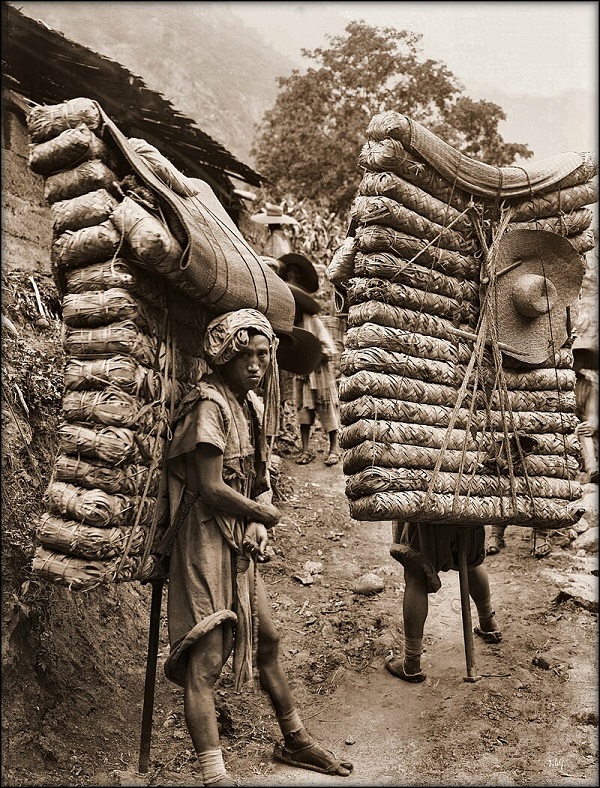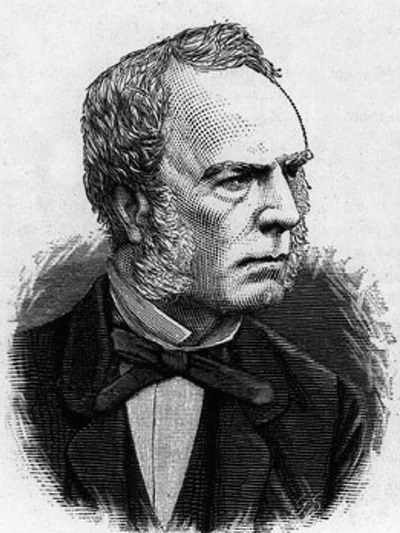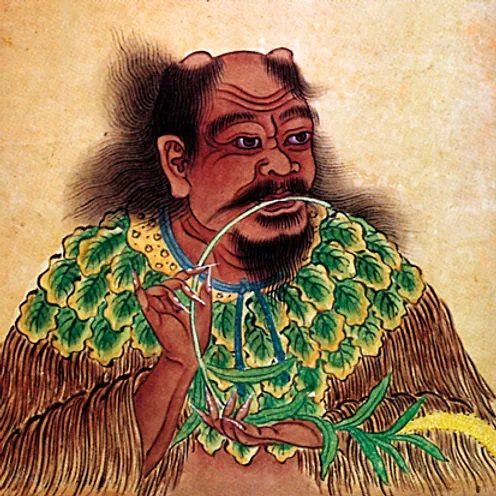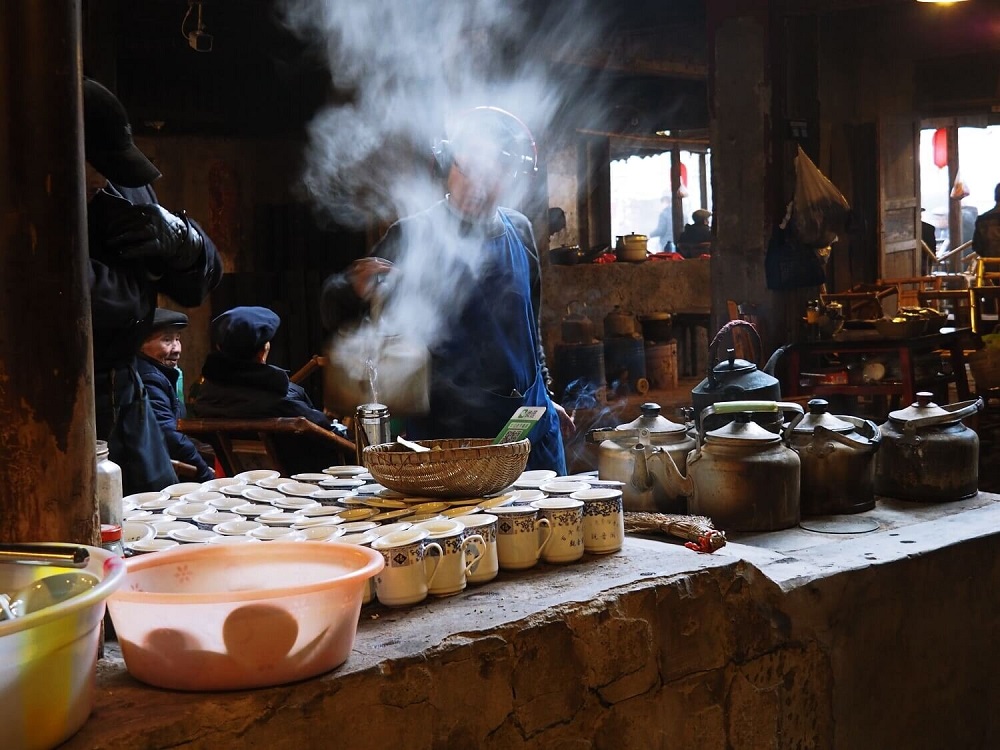Written by: Haroon Shuaib
Posted on: October 23, 2023 |  | 中文
| 中文
A traditional Chinese painting depicting a few friends enjoying tea and a conversation
Many inventions that have become essential for everyday life across the globe trace their origin to the land that today constitutes modern day China: paper, movable type printing, compass and mechanical clocks, gunpowder, silk, kites, porcelain, bronze, row crop farming, paper money, toothbrushes and tea.
According to an ancient saying, tea (茶 chá) has been an integral part of China's cultural heritage for over 5,000 years. Regarded as one of the seven necessities of life, the other six being: firewood (柴 chái), rice (米 mĭ), oil (油 yóu), salt (鹽 yán), sauce (醬 jiàng) and vinegar (醋 cù), while tea has claimed a central role in Chinese society. It is believed that tea was discovered in 2737 BC by Emperor Shen Nong (divine farmer), while resting under a tree. A leaf from a tree fell into a pot of boiling water placed beside him. The tantalizing aroma and refreshing effect of this concoction soon made tea a staple beverage of China. The first to develop the habit of drinking tea were Buddhist monks, as its caffeine concentration helped them focus on long hours of meditation. Tang Dynasty (618-907) saw tea became an important commodity in Silk Road trade, and Song Dynasty (960-1279) saw emergence of tea houses as centers for socializing. During Ming Dynasty (1368-1644), tea permeated further into culture and art of tea drinking, and its appreciation reached unprecedented sophistication. Gongfu Cha (工夫茶), a popular tea ceremony involving small brewing vessels and a high leaf-to-water ratio for maximum taste was formalized.
Chinese tea ceremony focuses on the harmony of tea, water, utensils, preparation, environment and conversation. Tea ware used ceremonially include tea tray, teapot, Gaiwan (Chinese bowl with a lid), tea filter, tea pitcher, fair cup, pinming cup for drinking tea, aroma cup for smelling the fragrance of tea and a tea holder. The ceremony begins with washing of hands, after which water is heated to rinse tea wares. Appropriate amount of tea leaves is put into tea pot, rinsed using hot water and left to brew. This liquid is then filtered into fair cup and finally poured into an aroma cup before transferring it into a pinming cup.
Over centuries, distinct varieties of tea continued to be cultivated in geographically and climatically distinct regions across China. Famous types of Chinese tea are black, green, yellow, oolong, white and pu-erh tea. Balance of body and mind is important in Chinese traditional medicine, and tea is believed to promote this balance. Today, it is estimated that over 2 billion cups of tea are consumed in China every day.
Tea, its scientific name is Camellia sinensis, is traditionally classified based on the techniques with which it is processed. Withering is the process of removing excess water from tea leaves through sun or wind exposure, promoting the breakdown of leaf proteins into free amino acids and increasing the availability of free caffeine. Oxidation involves housing tea leaves in a temperature-controlled room, where they turn darker as chlorophyll breaks down enzymatically and tannins are released. In fixation tea leaves are exposed to moderate heat to deactivate oxidative enzymes, and remove unwanted scents without damaging the flavor. Shaping is the process of rolling, kneading and forming the leaves into strips, pellets, spheres or other desired shapes. In drying, tea leaves are either sunned, panned, air-dried or baked and in fermenting process tea is exposed to humidity.
Green tea, containing least amount of caffeine among all tea types has remained the most common tea drink throughout the history of China. Cultivated mainly in Zhejiang, Jiangsu, Anhui, Henan, Hunan, Hubei, Guangxi and Guangdong provinces, fresh green tea leaves are steamed preserving the polyphenols and intensifying strong antioxidant benefits. White tea is the least processed form of tea, and mainly cultivated in the Fujian Province. White tea leaves are harvested when they are still covered with silvery white hair. This type of tea provides a more delicate flavor and contains second least amount of caffeine. Yellow tea is mainly cultivated in Hunan, Hubei, Sichuan, Guangdong, Zhejiang and Anhui. Oolong tea is derived from partially oxidized tea leaves and mainly cultivated in Fujian, Guangdong and Taiwan. Black Tea is stronger with a robust fruity taste and sweet aftertaste. Containing more caffeine than any other tea, black tea is mainly grown in southeast coastal region of China alongside Yunnan and Sichuan provinces. Dark fermented tea is made through the process of withering, shaping, fermentation and drying. Pu’erh is a variety of dark fermented tea prepared by leaving leaves to ferment over several months, even several years, enriching flavor and nutritious qualities. It is mainly grown in Hunan, Hubei, Guangxi, Yunnan, Sichuan and Shaanxi. Besides these more familiar types of teas, there are some peculiar flower and herbal teas such as chrysanthemum tea, wolfberry tea, jasmine tea and Osmanthus tea.
One tradition related to tea that is not widely known outside China is the technique of hydraulically pressing tea leaves into embossed tablets. These easy to transport and store tablets called bricks, are imprinted with details of type of tea, quality, weight and purity. Pieces are broken off these and crushed into powder for consumption as per requirement. In olden times, tea bricks were also used as a medium of exchange. Mongols and the various Chinese dynasties used them as currency during military and trade expeditions. This probably also introduced tea to other countries and regions. According to the documented records, tea finally reached Europe in the 1600s, along with the necessary tea wares manufactured in China. Once adopted by the West, potters in Europe added handles to tea cups to protect fingers from the heat transmitted through delicate porcelain. British had a habit of drinking hot black tea at higher temperatures than the usual Chinese green. The size of teacups grew to accommodate English taste for milk and sugar. Interestingly, till 18th century all tea came from China. It was around 1850 that a group of British businessmen set out to create a tea industry in a place under their control that was also close to China. Sarah Rose, a journalist and author in her book “For All the Tea in China: How England Stole the World's Favorite Drink and Changed History”, presents a very interesting account of the "greatest single act of corporate espionage in history (Sic!)." According to her, British deputed a botanist, Robert Fortune, to travel to the tea growing regions of China as a plant hunter and a spy. Disguised as a wealthy Chinese merchant, Fortune stayed in China for two years and sneaked out the tea plant and knowledge of processing tea leaves to India, where its cultivation was promoted. “It was the East India Trading Company at the time, one of the most important (if not the most important) multinational corporations in the world that had recruited Fortune to smuggle tea out of the country. They wanted really good tea stock from the very best gardens in China, and they also needed experts. They needed the Chinese to go to India to teach the British planters, as well as the Indian gardeners," Rose explained in an interview. According to Rose, Fortune not only succeeded in this but within his lifetime, India surpassed China as the world's largest tea grower.
The centuries-old tea culture attracted new interest worldwide with the addition of “the traditional tea processing techniques and associated social practices in China”, to the Representative List of the UNESCO Intangible Cultural Heritage of Humanity in 2022. According to some estimates, today China produces more than 2000 tea products including processing tools such as woks, bamboo trays and drying frames. Fujian Province, famous for its oolong tea, is home to one of the oldest and largest tea gardens in the world due to its natural environment. According to UNESCO, China's tea culture has helped in nurturing many beneficial social practices, traditional skills, handicrafts and reflect Chinese people's values of modesty, harmony and respect. With its known medicinal qualities, including slowdown of aging, with its anti-cancer and anti-inflammation properties, an ability to reduce blood fat and indigestion, tea remains one of the most favored home potions across the globe. It is widely believed that tea helps eliminate fatigue, improves eyesight, promotes better blood sugar control and prevents people from feeling the intensity of heat. It is no surprise that tea has also been a subject of preference in Chinese art, music and literature. Lu Yu, a Chinese tea master poet, author and calligrapher of the 8th century known as Sage of Tea wrote:
The first bowl sleekly moistened throat and lips;
The second banished all my loneliness;
The third expelled the dullness from my mind,
Sharpening inspiration gained from all the books I've read.
The fourth brought forth light perspiration,
Dispersing a lifetime's troubles through my pores.
The fifth bowl cleansed every atom of my being.
The sixth has made me kin to the Immortals.
The seventh is the utmost I can drink.




You may also like: